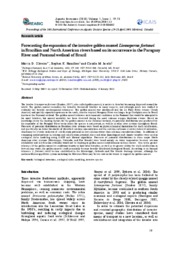Forecasting the expansion of the invasive golden mussel Limnoperna fortunei in Brazilian and North American rivers based on its occurrence in the Paraguay River and Pantanal wetland of Brazil.
Forecasting the expansion of the invasive golden mussel Limnoperna fortunei in Brazilian and North American rivers based on its occurrence in the Paraguay River and Pantanal wetland of Brazil.
Author(s): OLIVEIRA, M. D. de; HAMILTON, S. K.; JACOBI, C. M.
Summary: The bivalve Limnoperna fortunei (Dunker, 1857), also called golden mussel, is native to Asia but becoming dispersed around the world. The golden mussel resembles the invasive dreissenid bivalves in many respects, and although much less studied it evidently has broader environmental tolerances. The golden mussel was introduced into the La Plata River estuary (South America) and quickly expanded upstream to the north, into the tropical Paraguay River reaching a large floodplain area in Brazil known as the Pantanal wetland. The golden mussel tolerates environmental conditions in the Pantanal that would be inhospitable for most bivalves, but mussel mortality has been observed during the most extreme oxygen depletion events. Based on knowledge about the limiting factors for the golden mussel in the Pantanal wetland, its potential distribution was predicted for the remainder of the Paraguay River basin where the species is not present, as well as in other river systems throughout Brazil. Forecasts of potential distribution in Brazilian river systems were based on physicochemical limitations for shell calcification, and specifically on lower thresholds of dissolved calcium concentrations and the calcium carbonate (calcite) index of saturation, which may be a better indicator of calcification potential in low-calcium waters than calcium concentration alone. In addition to examining spatial patterns in calcium and calcification potential, these and other limnological and climate variables were used in ecological niche modeling using GARP and Maxent algorithms. Forecasts of potential distributions in three major North American river systems (Mississippi, Colorado, and Rio Grande) were based mainly on water temperature because calcium availability and calcification evidently would not be limiting to golden mussel establishment in those waters. Due to the greater tolerance of the golden mussel to conditions known to limit other bivalves, as well as its greater ability for shell calcification in low-calcium water, the golden mussel could potentially become broadly distributed throughout Brazil. According to its thermal tolerance L. fortunei could become established in the Mississippi, Colorado and Rio Grande drainage systems, although the northern Mississippi River system including the Missouri River may be too cool in the winter to support the golden mussel.
Publication year: 2010
Types of publication: Journal article
Unit: Embrapa Pantanal
Keywords: Biolological invasions
Observation
Some of Embrapa's publications are published as ePub files. To read them, use or download one of the following free software options to your computer or mobile device. Android: Google Play Books; IOS: iBooks; Windows and Linux: Calibre.
Access other publications
Access the Agricultural Research Database (BDPA) to consult Embrapa's full library collection and records.
Visit Embrapa Bookstore to purchase books and other publications sold by Embrapa.

